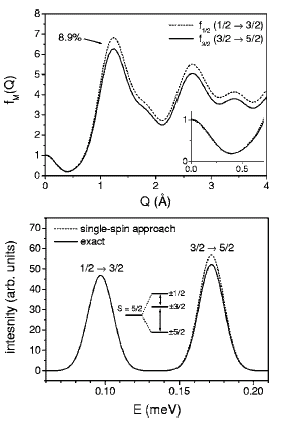Abstract of Publication No. 525
 O. Waldmann and H. U. Güdel
O. Waldmann and H. U. Güdel
Many-spin effects in inelastic neutron scattering and electron paramagnetic resonance of molecular nanomagnets
Phys. Rev. B 72, 094422/1-17 (2005)
![]()
![]()
Abstract:
Many molecular magnetic clusters, such as single-molecule magnets,
are characterized by spin ground states with defined total spin
S exhibiting zero-field splittings. In this work, the
spectroscopic intensities of the transitions within the ground-state
multiplet are analyzed. In particular, the effects of a mixing with
higher-lying spin multiplets, which is produced by anisotropic
interactions and is neglected in the standard single-spin
description, are investigated systematically for the two experimental
techniques of inelastic neutron scattering (INS) and electron
paramagnetic resonance, with emphasis on the former technique. The
spectroscopic transition intensities are calculated analytically by
constructing corresponding effective spin operators perturbationally up to
second order and consequently using irreducible tensor operator
techniques. Three main effects of spin mixing are observed. First, a
pronounced dependence of the INS intensities on the momentum transfer
Q, with a typical oscillatory behavior, emerges in first
order, signaling the many-spin nature of the wave functions in
exchange-coupled clusters. Second, as compared to the results of a
first-order calculation, the intensities of the transitions within
the spin multiplet are affected differently by spin mixing. This
allows one, third, to differentiate the higher-order contributions to
the cluster magnetic anisotropy which come from the single-ion
ligand-field terms and spin mixing, respectively. The analytical
results are illustrated by means of the three examples of an
antiferromagnetic heteronuclear dimer, the Mn-[3×3] grid molecule,
and the single-molecule magnet Mn12.